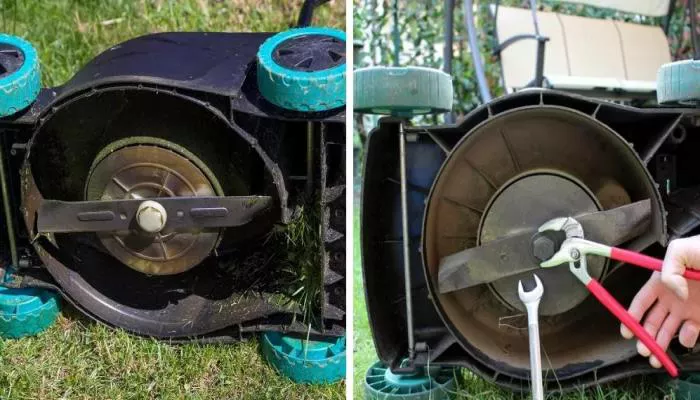A well-balanced lawn mower blade is essential for a smooth and efficient cut. An unbalanced blade can cause vibrations, uneven grass cutting, and even damage to the mower’s engine. These vibrations may travel through the entire machine, potentially loosening bolts and damaging internal components over time. Balancing the blade at home is a simple task that requires basic tools and careful attention, saving you money on professional servicing. This guide will walk you through the process step by step, ensuring your lawn mower operates at its best while maintaining optimal cutting performance throughout the season.
Why Balancing A Lawn Mower Blade Is Important?
An unbalanced blade creates unnecessary stress on the mower’s spindle and engine. Over time, this can lead to premature wear and tear. Additionally, an unbalanced blade may leave behind uneven patches of grass, making your lawn look untidy. By balancing the blade, you ensure a cleaner cut, reduce vibrations, and extend the life of your mower.
Tools Needed For Balancing A Lawn Mower Blade
Before starting, gather the necessary tools. You will need:
- A socket wrench or spanner to remove the blade
- A blade balancer or a simple nail and screwdriver setup
- A file or grinder for sharpening (if needed)
- Safety gloves and goggles for protection
- A sturdy workbench or flat surface
Having these tools ready will make the process smoother and safer.
Step By Step Guide To Balancing A Lawn Mower Blade
Removing The Blade
First, disconnect the spark plug to prevent accidental starts. Tilt the mower on its side, ensuring the air filter and carburetor face upward to avoid oil leaks. Use the socket wrench to loosen and remove the bolt holding the blade in place. Carefully take the blade off, noting its orientation for reinstallation.
Cleaning The Blade
Dirt, grass clippings, and rust can affect the blade’s balance. Use a wire brush or cloth to clean both sides thoroughly. Inspect the blade for cracks or excessive wear. If the blade is damaged, replace it instead of balancing it.
Checking The Current Balance
Place the blade on a balancer. A commercial blade balancer is ideal, but a nail or screwdriver can work as a makeshift tool. If one side of the blade dips lower, it means that side is heavier. Mark the heavier side with chalk or a marker for reference.
Adjusting The Balance
If the blade is unbalanced, you need to remove small amounts of metal from the heavier side. Use a file or grinder to shave off thin layers evenly. Check the balance frequently to avoid overcorrecting. The goal is to have the blade sit perfectly level on the balancer.
Reinstalling The Blade
Once balanced, reattach the blade in its original position. Tighten the bolt securely, but avoid over-tightening, as this can damage the spindle. Reconnect the spark plug and test the mower to ensure smooth operation.
Common Mistakes To Avoid
Skipping safety precautions: Always disconnect the spark plug before working on the blade.
Ignoring blade damage: A cracked or bent blade should be replaced, not balanced.
Over-filing the blade: Removing too much metal weakens the blade and affects its cutting ability.
Improper reinstallation: Installing the blade upside down can reduce cutting efficiency.
Tips For Maintaining A Balanced Blade
Regularly inspect and clean the blade after each use. Sharpen the blade as needed to maintain its cutting edge. Store the mower in a dry place to prevent rust. Following these tips will help keep your blade balanced and your lawn looking great.
When To Seek Professional Help?
If balancing the blade does not reduce vibrations, the issue may lie elsewhere. Worn spindle bearings, engine problems, or a bent crankshaft can also cause vibrations. In such cases, consult a professional for a thorough inspection.
Additional Considerations For Blade Maintenance
Frequency of Balancing
Even if your mower seems to run smoothly, it’s good practice to check the blade balance at least once per mowing season. Frequent use can gradually wear down one side of the blade more than the other.
Sharpening vs. Balancing
While sharpening focuses on maintaining a keen cutting edge, balancing ensures even weight distribution. Both processes are equally important for optimal mower performance. A sharp but unbalanced blade will still cause vibrations and uneven cuts.
Alternative Balancing Methods
If you don’t have a commercial balancer, you can use a simple DIY method. Hang the blade horizontally on a nail or screwdriver. If one side consistently tilts downward, that side is heavier and needs adjustment.
Environmental Factors
Wet grass and debris can stick to the blade, temporarily affecting its balance. Always clean the blade thoroughly before assessing its balance to avoid false readings.
Conclusion
Balancing a lawn mower blade at home is a straightforward process that improves performance and extends the life of your mower. With the right tools and careful attention, you can achieve a perfectly balanced blade in no time. Regular maintenance ensures your mower stays in top condition, providing a clean and even cut every time.
By following this guide, you can confidently balance your lawn mower blade and enjoy a well-maintained lawn with minimal effort. Remember that proper blade care not only enhances cutting efficiency but also prevents long-term damage to your equipment. A little time spent on maintenance now can save you from costly repairs later.
Related topics:
- HOW TO SHARPEN MANUAL LAWN MOWER BLADES WITH A FILE
- WHO MAKES MASPORT LAWN MOWERS
- 4 BEST CORDED LAWN MOWERS: A COMPREHENSIVE GUIDE

